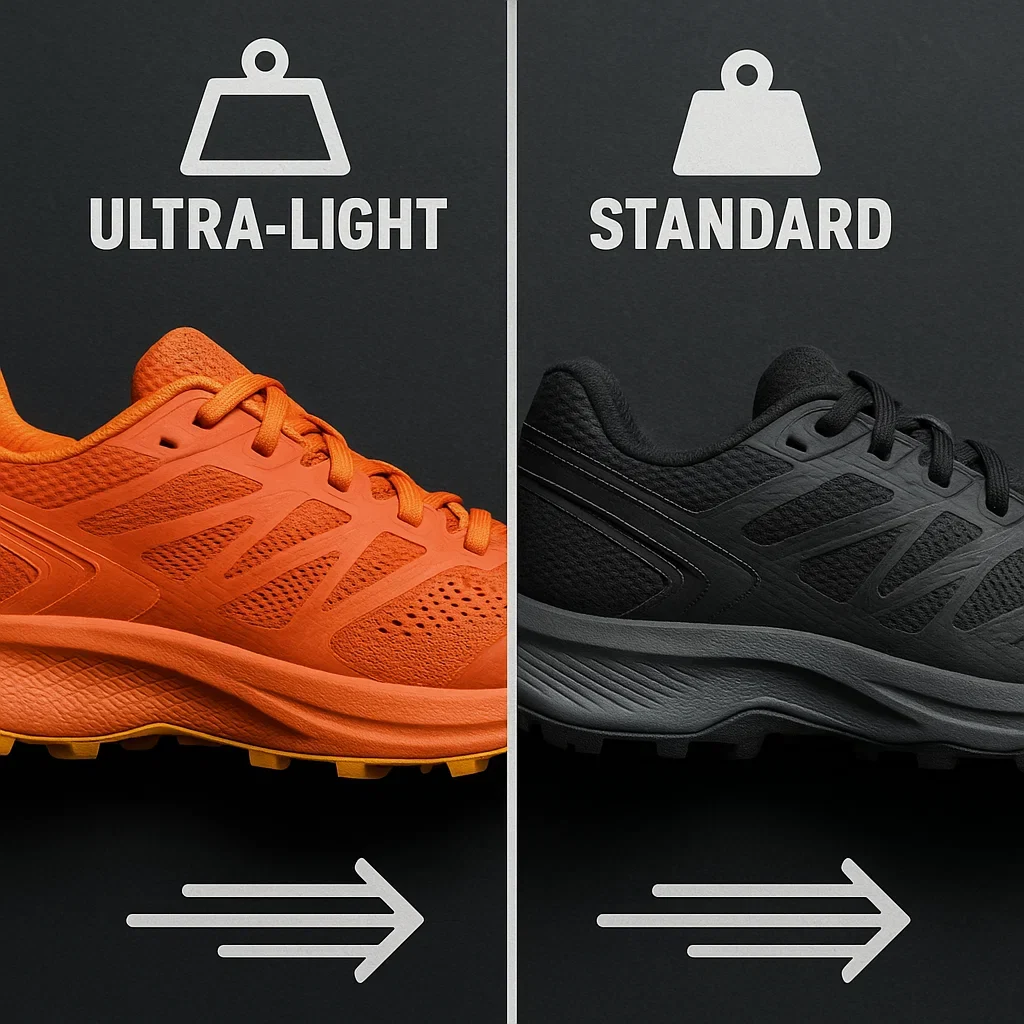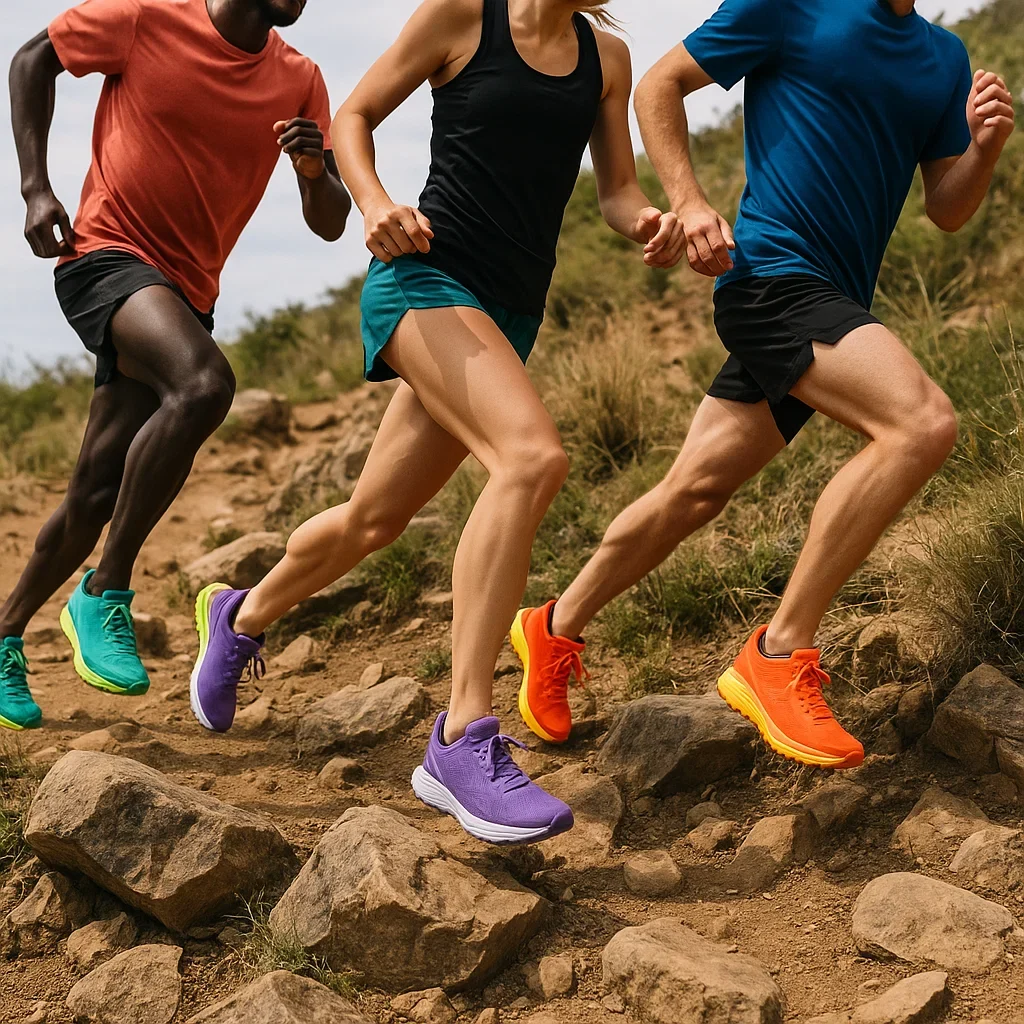Can lightweight trail running shoes survive a 100K ultra marathon?
Will you gain speed or sacrifice comfort and protection? Here’s your ultimate, science-backed, runner-tested guide—complete with comparison tables, decision tools, real stories, and expert tips. Run lighter, run smarter!
- Pros: Faster leg turnover, less fatigue over short distances, responsive ride, agile footwork on technical trails.
- Cons: Less protection for long rocky descents, midsole may compress faster, less underfoot cushion for 10+ hours, risk of foot fatigue and bruising late in the race.
- Key Question: Will your speed gain outweigh the comfort and durability you might lose in the last 40K?
🏷️ Lightweight vs Standard Trail Shoes – 100K Ultra Comparison
| Feature | Lightweight Shoe | Standard Shoe |
|---|---|---|
| Weight | 180–260g | 270–340g |
| Cushion | Low to moderate | Moderate to max |
| Rock Protection | Basic or flexible plates | Stiffer plates, thicker foam |
| Durability | 300–500 km | 400–700 km |
| Drainage/Breathability | Excellent | Good–Moderate |
| Best For | Speed, racing, technical, dry | All-day comfort, mixed terrain |
🧭 Decision Flow: Are Lightweight Shoes Right for Your 100K Ultra?
- Are you aiming for a fast finish (sub-12h)? → Yes: Lightweight may suit.
- Do you run efficiently, low-impact, few foot injuries? → Yes: Lightweight OK.
- Do you train/race on rocky or technical trails? → No: Choose more cushion/protection.
- Have you finished a 50K+ ultra in light shoes before? → Yes: Upgrade to light 100K models.
- Do you blister or bruise late in races? → Yes: Go for standard/protected models.
- Test: Can you do a back-to-back 30km long run in lightweight shoes with no major pain? If yes, you’re ready to race 100K light!
🏃♀️ Runner Stories: Who Thrives in Lightweight Shoes at 100K?
– Maya, mountain ultrarunner
– Carlos, speed-focused ultra finisher
– Jamie, trail marathoner turned ultrarunner
- Have you run at least one 40km+ long run in lightweight shoes?
- Do your feet blister easily? (If yes, be cautious!)
- Do you race on soft or dry trails, not rocky mountain courses?
- Are you under 80kg (176 lbs) or a “light stepper”?
- Have you had issues with shoe durability in past ultras?
- Do you rotate shoes in training to avoid excessive midsole breakdown?
🔗 Explore More 100K Ultra Shoe Guides
❓ Advanced FAQ: Lightweight Trail Shoes for 100K Ultras
👟 Are lightweight shoes safe for rocky 100K courses?
💡 How can I avoid foot fatigue or pain in minimal shoes?
⚡ Do elite runners always use lightweight shoes for 100K?
🔄 How often should I replace lightweight shoes in ultra training?
🦶 Can heavier runners use lightweight shoes for 100K?
🗣️ Lightweight or Standard: What Real 100K Runners Chose
– Mike, sub-12h 100K runner
– Tara, veteran ultramarathoner
🏆 Pro Tips & Pitfalls: Master Lightweight Shoes in 100K
- Tip: If going light, tape hotspots & toes in advance, especially if you’re prone to blisters.
- Tip: Practice aid station shoe checks—tighten laces, check foot swelling, swap socks if needed.
- Tip: Stash a backup pair (standard shoe) at a drop bag for emergencies.
- Mistake: Not practicing downhills in light shoes—risk of toe bang and black nails increases late in a 100K.
- Mistake: Using ultralight shoes with worn-out midsoles—don’t let pride ruin your race!
- Bonus: Record shoe mileage & terrain in a log. Helps spot wear patterns and plan next gear buy.
🧼 Care & Durability: Make Lightweight Shoes Go the Distance
- Dry shoes after every wet run—never use direct heat (damages glue/foam).
- Brush mud out of mesh and outsoles after every race.
- Rotate shoes (2+ pairs) during 100K training.
- Check midsole compression—replace if foam doesn’t spring back.
- Use insoles or gel pads if needed, but test before race day.
- Patch small tears with glue or athletic tape for temporary fixes.
📚 Further Reading & Related Guides
Share This Guide!
Final Thoughts
Lightweight trail shoes can transform your 100K race—if you’re prepared. Know your course, your body, and your footwear, and train with honesty. Don’t let the lure of speed steal your comfort and finish line dreams. With the right approach, you’ll run faster, lighter, and finish with a smile. Good luck out there!


About the Author
Lost Pace is an ultramarathon runner, shoe-tester and the founder of umit.net. Based year-round in Türkiye’s rugged Kaçkar Mountains, he has logged 10,000 + km of technical trail running and completed multiple 50 K–100 K ultras.
Blending mountain grit with data, Lost analyses power (CP 300 W), HRV and nutrition to craft evidence-backed training plans. He has co-written 260 + long-form guides on footwear science, recovery and endurance nutrition, and is a regular beta-tester of AI-driven coaching tools.
When he isn’t chasing PRs or testing midsoles, you’ll find him sharing peer-reviewed research in plain English to help runners train smarter, stay healthier and finish stronger.
Ultrarunner · Data geek · Vegan athlete

